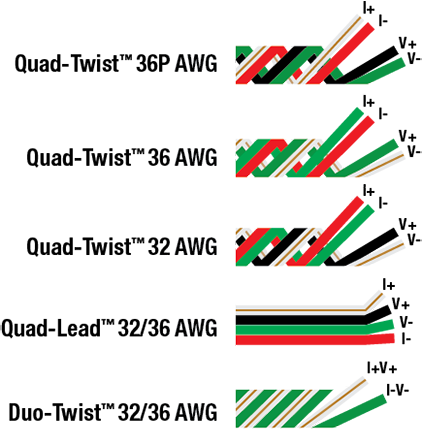Sensors with Lead Extensions
(formerly SMODs)
Order sensors with lead extensions
Adding extra wire to your sensor leads can be cumbersome and time consuming. Lake Shore offers this service for you at the time of order, allowing numerous options to best suit your application.
There are various options available when selecting a lead extension:
Number of wires
4-wire: For accurate sensor measurements, 4-lead connections are by far the superior option when adding a lead extension to both diodes and resistive temperature sensors. See Appendix C and Appendix E of the Temperature Measurement and Control Catalog for additional information.
2-wire: This option is useful if the number of electrical connections inside a system must be kept to a minimum. However, 2-lead connections add measurable resistance to sensor measurements as described in Appendix E. This additional resistance will cause a significant (but repeatable) shift on all sensors except diodes.
Wire type
Phosphor bronze: This all-purpose cryogenic wire has a great balance of features.
- Low thermal conductivity minimizes heat leak (lower is generally better)
- Moderate electrical resistance (lower is generally better)
- Non-ferromagnetic and very low magnetoresistance, making this wire the best choice for applications where magnetic fields are present
- Available in several convenient configurations in addition to single strand, such as Quad-Lead™ and Quad-Twist™
Manganin: This wire has several interesting characteristics that make it useful in certain situations.
- Coefficient of thermal expansion very close to that of pure copper
- Very low thermal conductivity minimizes heat leak (lower is generally better)
- Somewhat high electrical resistance (lower is generally better)
- Heavy Formvar® insulation limits upper temperature of wire to 378 K
- Non-ferromagnetic
- Available as single strand wire only
Wire gauge
|
Various wire thicknesses are available, depending on the wire type selected. The wire gauge selection process usually involves a compromise between thermal conductivity and ease-of-use, with thinner wire being preferred to reduce thermal conductivity and thicker wire being easier to handle and work with. Lake Shore uses American wire gauge (AWG) for its wire. This conversion table is provided for your convenience.
32 AWG and 36 AWG are our preferred wire gauges to use with cryogenic sensors. By far they provide the best balance between reduced thermal conductivity and ease-of-use.
Manganin is the only wire type available in 30 AWG as the extremely low thermal conductivity of the wire helps compensate for the “large” cross-sectional area associated with 30 AWG.
Phosphor bronze is the only wire type available in 42 AWG. This wire thickness reduces thermal conductivity substantially to the levels possible with manganin, with the same low magentoresistance of phosphor bronze. Unfortunately, this wire is extremely delicate and can break easily. Lake Shore suggests this wire be ordered only by users with extensive experience with system wiring.
Wire insulation
Polyimide
Polyimide insulation is by far the most versatile insulation option available for cryogenic wiring. It will operate at temperatures in excess of 493 K (220 °C) for intermittent duty and has exceptional resistance to chemical solvents and burnout. Polyimide exhibits excellent resistance to radiation exposure and as such is used extensively in spaceflight and high-energy physics applications. Polyimide can be removed mechanically during terminal preparation and is rated to 3525 VAC for 32 AWG, and 2525 VAC for 36 AWG.
Polyvinyl formal (Formvar®)
Formvar® has excellent mechanical properties such as abrasion resistance and flexibility. The film will stand excessive elongation at low temperature without rupture, making it a great choice for wiring applications with tight bend radii at ultra-low temperatures. However, care is advised, as Formvar® has a tendency to craze upon contact with solvents such as toluene, naphtha, and xylol, therefore, it should be given an annealing preheat prior to varnish application. Formvar® can be removed mechanically during terminal preparation and is rated to 3525 VAC for 32 AWG, and 2525 VAC for 36 AWG.
Wire length
Standard lengths of 2 m and 5 m are offered with all wire types and gauges. These lengths have been selected to suit a wide range of applications, most commonly wiring from a temperature sensor through the various stages of a cryostat, up to and terminating at an electrical feedthrough. Additional wire may be trimmed from both of these wire lengths if necessary. However, if a custom length is required, please contact Lake Shore to discuss custom wire lengths.
Component temperature limits
The lead extension components have different maximum temperatures. Use this chart to ensure the lead extensions you order are appropriate for your given application.
| |||||||||||||||||||
Recommended standard lead extensions
Lake Shore recommends selecting from one of these two configurations — our most popular configurations due to the wide range of applications they cover.
-QL
Quad-Lead™ phosphor bronze, 32 AWG, 2 m
For situations where ease-of-use and ruggedness is important.
- 32 AWG wire is easier to prepare and solder to that thinner gauges
- Quad-lead™ wire is easy to heat-sink around copper bobbins due to its ribbon structure
- Polyimide insulation is strong and is resistant to solvents, and also has a high temperature rating that protects it from heating that might be applied to help soften the bonding agent used to join the wires to one another
-QT
Quad-Twist™ phosphor bronze, 36 AWG, 2 m
For noisy environments where signal integrity must be protected.
- Quad-twist™ wire helps reject electromagnetic interference that may be present inside the measurement space
- 32 AWG wire is easier to prepare and solder to that thinner gauges
- Quad-twist™ can be slightly more difficult to heat-sink, but the 36 AWG wire reduces thermal conductivity and therefore reduces heat-leak naturally
- Formvar® insulation has excellent mechanical properties such as abrasion resistance and flexibility, which is important when using 36 AWG wire. However, care should be taken as Formvar® can craze when exposed to solvents.
There are certain scenarios where these standard offerings are not adequate and alternative solutions should be selected. One such example is higher-temperature applications above 450 K where both Quad-Lead™ wire and Formvar® insulation become inappropriate. This application would require Quad-Twist, 32 AWG. In this scenario, please use the full part configurations to define the lead extension.
| -XXYY -Z | |
| XX | = Wire type |
| YY | = Wire gauge (AWG) |
| Z | = Length in meters |
Method of ordering
When ordering a lead extension on the website, add the sensor to the shopping cart first, and then come to this page to add a lead extension.
If placing a purchase order, please append the lead extension part number to the sensor that requires the extension. Examples:
| CX-1050-SD-HD-4L-QL | Quad-Lead™, 32 AWG, 2 m |
| DT-670-CU-1.4L-QT | Quad-Twist™, 36 AWG, 2 m attached to 0.91 m of Quad-Lead™, 36 AWG wire that comes standard with the diode CU package. |
| PT-102-14L-QT32-5 | Quad-Twist™, 32 AWG, 5 m |
| DT-670C-SD-DT32-2 | Duo-Twist™, 32 AWG, 2 m |
Lead extensions are not available on devices with gold or no leads
Adding a lead extension to a sensor with leads does not change the type of wire used for the sensor. Contact Lake Shore directly to discuss a modified sensor wire option.
Using this sensor above 450 K?
Standard SMOD leads are attached with 63//37 SnPb solder, intended for use below 450 K. All lead extensions soldering is performed to J-STD-001 Class 2 quality standard.
If the sensor is to be used between 450 K and 500 K, higher temperature 90/10 PbSn solder must be specified. Add -H to the end of the lead extension part number.
If the sensor is to be used above 500 K, contact Lake Shore.
Note: Formvar® insulation is limited to use below 378 K.

Lead extension specification overview
| Wire design | AWG | # of wires | Wire material | Insulation | Max temperature | Additional notes |
| QL (Quad-Lead™) | 32 | 4 | PhBr |  | 433 K | |
| 36 |  | 433 K | ||||
| QT (Quad-Twist™) | 32 | 4 | PhBr |  | 500 K | |
| 36 |  | 378 K | *Polyimide option available upon request | |||
| MW (Manganin wire) | 30 | 4 | Manganin |  | 378 K | |
| 32 |  | |||||
| 36 |  | |||||
| NM (Non-magnetic wire) | 32 | 4 | PhBr |  | 500 K | |
| 36 |  | 378 K | ||||
| DL (Duo-Lead™) | 36 | 2 | PhBr |  | 433 K | Not for use on RTDs |
| DT (Duo-Twist™) | 32 | 2 | PhBr |  | 500 K | Not for use on RTDs |
| 36 |  | Not for use on RTDs | ||||
| DM (Manganin wire) | 30 | 2 | Manganin |  | 378 K | Not for use on RTDs |
| 32 |  | Not for use on RTDs | ||||
| 36 |  | Not for use on RTDs | ||||
| DN (Non-magnetic wire) | 32 | 2 | PhBr |  | 500 K | Not for use on RTDs |
| 36 |  | 378 K | Not for use on RTDs | |||
| 42 |  | Not for use on RTDs | ||||
 represents
Formvar represents
Formvar  represents Polyimide represents Polyimide
 represents Polyimide with Bond 999 represents Polyimide with Bond 999 | ||||||

